|
BULB LOG 42 --- 17th October 2007

Colchicum 'Water Lily' clump
The plant world is full of incredible beauties so why on earth would we want to grow such a mutation as Colchicum 'Water Lily' ? It is a good doer in that it increases at a steady rate and it is also very reliable, flowering well every single year but is it nice?

Colchicum 'Water Lily' flower
I suppose when you look at a flower in isolation it has the charm of a double, if you like that sort of thing, but that is at the cost of the simple beauty of a perfect colchicum flower which I much prefer. Having said all that I do have a soft spot for it and have retained a small clump or two in the garden but it is not my favourite by a long way.

Removing tree
The big task for last weekend was to remove three threes from the garden. We have plenty trees in our garden and possibly could have too many but I have a love of them and cannot help myself growing them on from seed and just sneaking them in here and there - they are not easy to hide after a year or two's growth. Anyhow, three rowans were suffering from die back and we decided that they had to go. You can see we have removed the entire canopy from the tree on the right and having dug as far down as I can at the base of the trunk I am now using a winch attached to another of the fated trees to pull it over to help me get at the roots which I cut near the bowl with a saw. After much rugging, tugging and sawing I have now completely removed two trees - the third one can wait a while until I recover from the hard work.
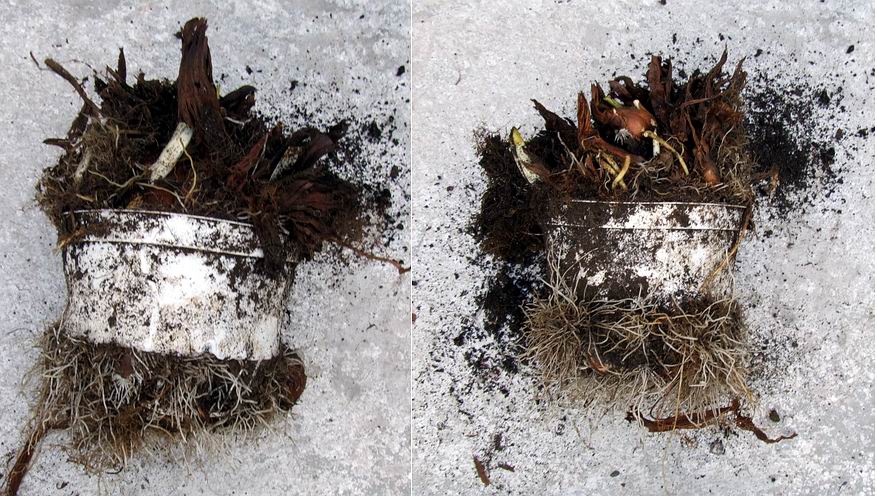
Colchicum in plunge basket
As I was digging around one of the trees to lift all the bulbs to safety I discovered that one group of Colchicums were still in a small mesh plunge pot which has become slightly congested.never believe that they were all growing in such a small container.
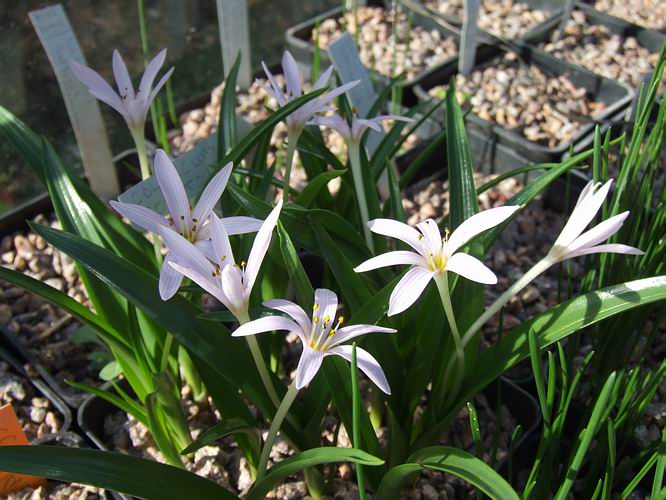
Colchicum coustourierii
Back in the bulb house, the bulbs are better tended and never allowed to get quite so congested as those poor colchicums. Colchicum coustourierii flowers well every year - it is not that different from C. cupanii and I must remember to try some outside in my small new sand plunge.
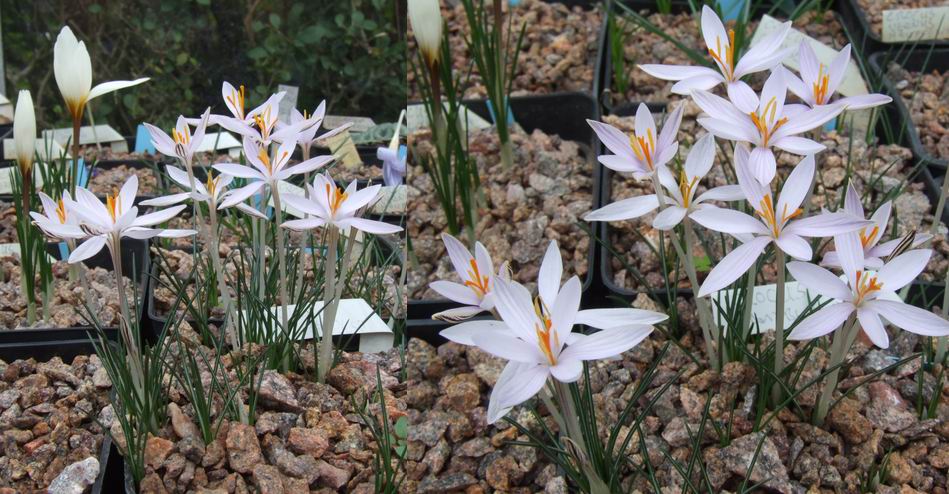
Crocus cambessedesii x2
A real wee beauty with its dark stripped exteriors is Crocus cambessedesii. One of the smallest crocus and a favourite of Maggi.
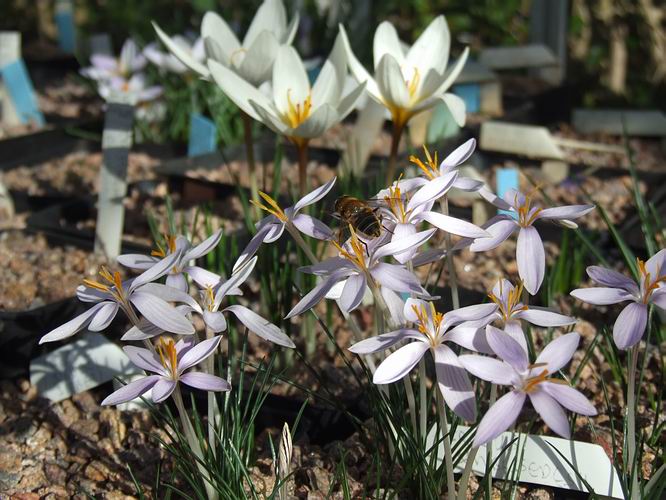
Crocus cambessedesii
When ever the sun comes out, and we have seen a lot of sun in Aberdeen recently, the hover flies and bees are paying great attention to the crocuses.

Crocus laevigatus with bee and hover fly
Another very reliable crocus that sets good seed every year is Crocus laevigatus.

Crocus laevigatus from side
As you will see Crocus laevigatus also has well developed leaves when it flowers, this is a good indicator that it also needs watered. My rule of thumb is after the two autumn storms to water directly into the pots in proportion to the amount of leaf growth. Some crocus species flower well ahead of the leaves appearing so I do not water them until the leaves appear but I have been watering any crocus with leaves showing. I do not intend to make the mistake that I made last year of keeping them on the dry side when they needed water and that is now when their leaves are growing.
There should be sufficient nutrient in the compost to keep them fed meantime. Supplementary feeding will in early spring. Once the leaves are well developed watering can be adjusted over the winter so as the pots remain moist until the spring when they will need some extra watering again to fuel the growth of the new corm.

Crocus laevigatus
I am not leaving the pollination to the insects I am out with my paint brush, cross pollinating, to give the flowers the maximum chance of setting seeds. These pots of Crocus laevigatus are all seed raised and show some interesting variation in colour.

Pollinator on Crocus robertianus
Why do I need to bother with my paint brush when there are bees and hover flies? This picture has one answer - can you spot it? The way the stamens of Crocus robertianus are held the hover fly can visit the flowers without ever touching the stigmatic surface so I need to transfer some pollen just to be sure. Obviously the very different designs of crocus styles must have evolved in conjunction with a particular pollinator in their natural habitat and the insects in our garden may not be the correct shape to successfully pollinate the flowers.

Crocus robertianus
This is the first flower of this form of Crocus robertianus from Gothenburg seeds sown in February 2004.
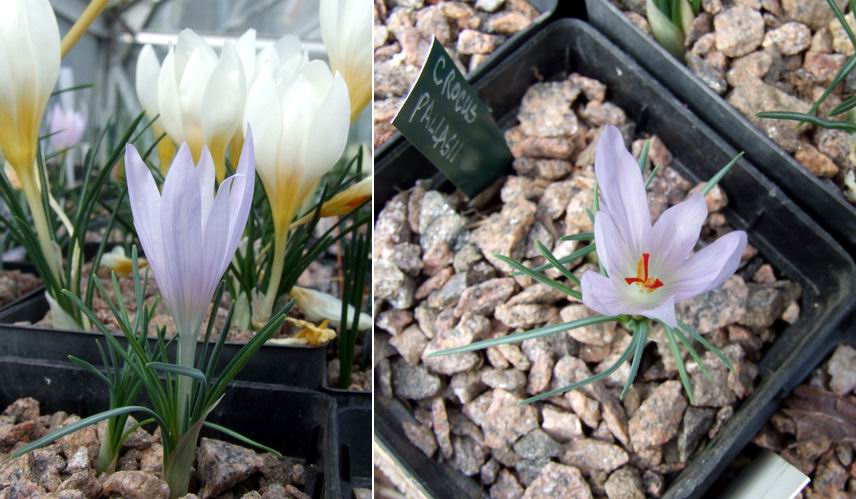
Crocus pallasii
Two views of Crocus pallasii: not one that I find that easy as I think it prefers a hotter drier climate than we have - I do struggle on with a number or forms and this is one I got from Tony Goode.

Two colour forms of Crocus kotschyanus
Just to illustrate the variation you can get especially if you raise your bulbs from seed here are two colour forms of Crocus kotschyanus a pale form in front of a nice dark one.
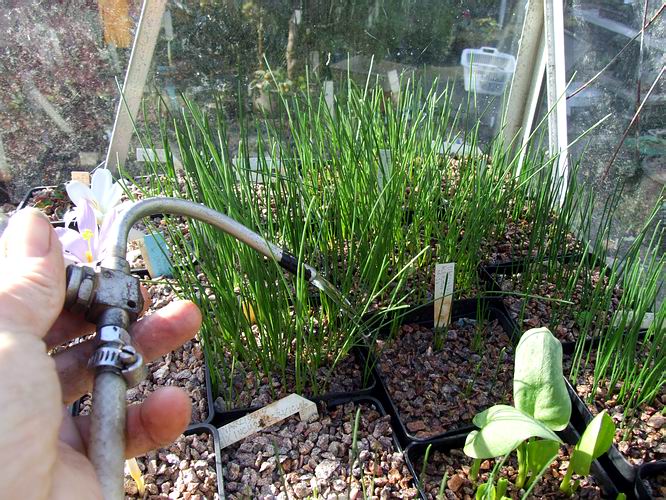
Watering Narcissus
As with the crocus pots I am watering the Narcissus in proportion with the amount of leaves showing. Many of the winter flowering narcissus such as N. romieuxii have a lot of leaf growth just now so I am watering them directly into the pots. We are experiencing temperatures approaching 20C out side so it is warmer in the bulb houses and the plants with leaves are losing water quickly so it is essential that I replace that water to allow them to grow unchecked by drought.
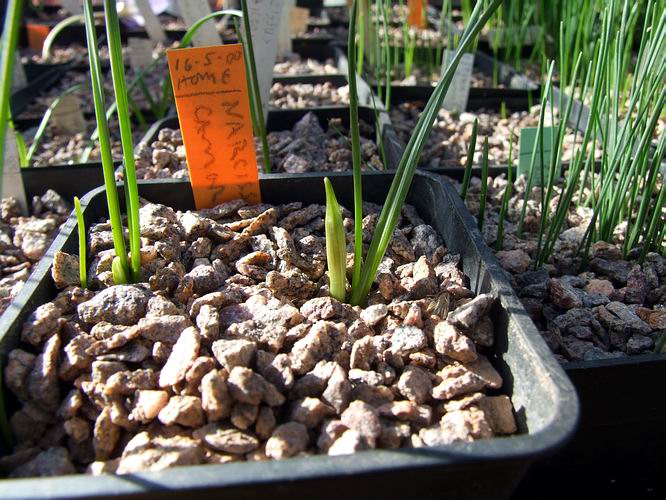
First Narcissus buds
Even the first Narcissus buds are showing on this pot of bulbs which is seed raised from N. 'Camoro'; they could be in flower before the end of October.
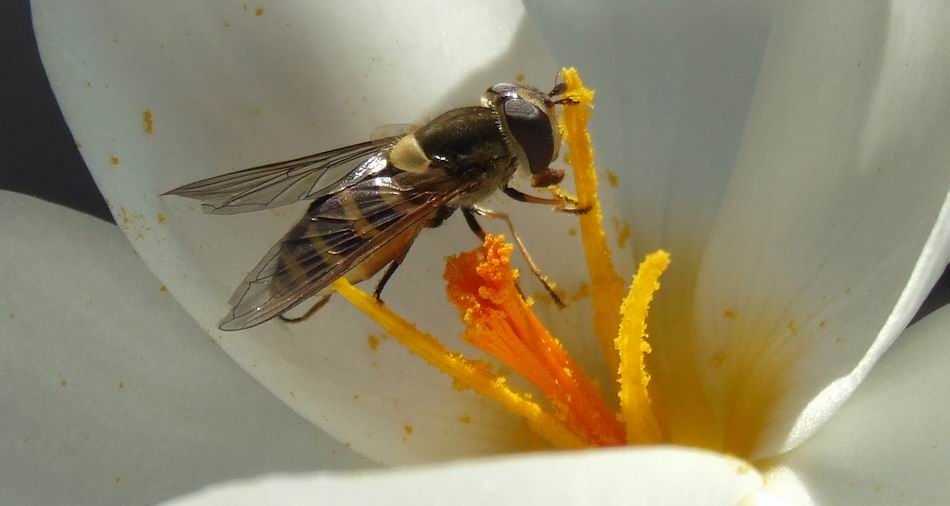
Pollinator on crocus
I will sign off this week with another shot of a hover fly efficiently pollinating this crocus species.
^ back to the top ^
|

